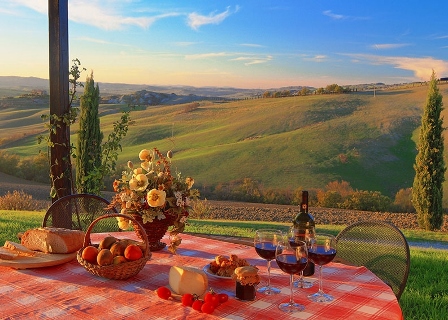
WTI Magazine #79 2016 May 13
Author : italia.it Translation by:
The magnificent natural scenery of the Val d'Orcia that extends through the Tuscan hills was inserted onto the UNESCO World Heritage List in 2004. Val d'Orcia fuses art, landscape and ecosystem in one geographical space, and is the expression of a series of marvelous natural characteristics. It is also the result of and testament to the people that has long-inhabited it.
In fact, according to UNESCO this Valley is an exceptional exemplar of the way in which a natural setting was redesigned during the Renaissance (14th-15th Centuries), reflecting the ideals of good governance in the Italian City-State. Additionally, these splendid localities were celebrated by the painters of the Sienese School, which flourished between the 13th and 15th Centuries.Val d'Orcia The images of Val d'Orcia, and particularly the reproductions of their landscapes, in which they depict citizens living in harmony with nature, became icons for the Renaissance Age. A perfect example is Ambrogio Lorenzetti's fresco cycle "Allegories and Effects of Good and Bad Government" in Siena's Palazzo Pubblico from c. 1338-39. The cycle is not only a masterpiece in artistic terms, but a work that goes above and beyond merely artistic value: it transcends such, also comprising architectonic, environmental and social themes.
Gently-rolling hills covered in the dense vegetation of vineyards, olive groves, cypresses, beech and chestnut trees alternate with Medieval habitations, rural villas and castles boasting impervious towers – all of which is diffused in a tranquilly-isolated nature. This is the scenario that is laid out before the eyes of the visitor to Val d'Orcia – just as evocative in real life as it is when depicted by the Sienese Masters.
Five-million years of geological history have left their mark on this territory that, today, is abundant in plant and animal species. Even the deposits of lava from volcanoes no longer active – such as Mounts Radicofani and Amiata – have contributed to the delineations and details of the area; the lava, hardened, gave form to those dark stones known as trachytes. The trachytes succeed each other one after the other, accompanying the River Orcia a sit cuts the Valley in two, before exiting via a deep cleft.
Val d'Orcia has weaved its history with the Via Cassia, the extremely long Roman road that links Rome to Northern Italy, crossing through the entire Val d'Orcia. History travels this ancient via consulare that has been witness to the turn of time through the centuries, in this part of Tuscany that is a dream coveted by many. A street that traces the history of the Via Francigena means that the thrill of the journey resides in the sense and spirit of the pilgrimage of the faithful.
The continuous transit of men and commerce along this fundamental pathway connoted the importance of town centers that eventually attracted the interest of the Republic of Siene in the 15th Century.
After the mid-1500s, Val d'Orcia became a valuable part of the Florentine orbit – together with the Sienese dominions – solely for its important agricultural aspect.
Castiglione d'Orcia, Montalcino, Pienza, Radicofani and San Quirico d'Orcia are the five splendid communes that have chosen to re-appraise the Park of Val d'Orcia, protecting the environment and the territory, and promoting the Val d'Orcia "brand."
Contignano, Monticchiello, Bagno Vignoni, Rocca d'Orcia, Campiglia d'Orcia, Bagni San Filippo, and Vivo d'Orcia are some of the other magnificent spots scattered throughout the Valley – all are ideal jumping-off points from which to take a trip back into its fascinating and richly-evocative past. The richness and variety of the scenery are not the only unique elements that characterize the area's pristine terrain; there is also the enogastronomic production, indeed one of Val d'Orcia's primary fortes. Such includes the cacio pecorino of Pienza, the honey from Val d'Orcia, extra-virgin olive oil from Castiglione d'Orcia, the salames of Cinta Senese, as well as mushrooms, truffles, and everything else that is, of course, accompanied by the most famous wine in the world - Brunello di Montalcino.



